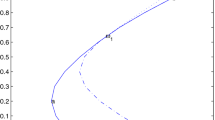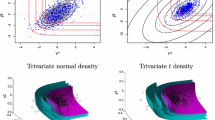Abstract
We use NORTA (NORmal To Anything) to enhance normal credit-risk factor settings in modeling common risk factors and capturing contagion effects. NORTA extends the multivariate Normal distribution in that it enables the simulation of a random vector with arbitrary and known marginals and correlation structure. NORTA can be solved either by numerical integration (Cario and Nelson in Modeling and generating random vectors with arbitrary marginal distributions and correlation matrix, Technical report, Department of Industrial Engineering and Management Sciences, Northwestern University, IL, 1997) or by Monte Carlo simulation (Ilich in Eur J Oper Res 192(2):468–478, 2009). The former approach, which is the most efficient, assumes that the marginals’ inverse cumulative functions are given, while the latter, which is more flexible but less efficient, does not. We show how to combine both approaches for higher flexibility and efficiency. We solve for NORTA and experiment with Normal, Student, and Asymmetric Exponential Power (AEP) distributions. We match NORTA models to Normal models with the same marginals’ first and second moments. Yet, differences in credit-risk measures can be highly significant. This supports NORTA as a viable alternative for credit-risk modeling and analysis.



Similar content being viewed by others
References
Abate, J., & Whitt, W. (1992). The Fourier-series method for inverting transforms of probability distributions. Queueing Systems, 10(1), 5–87.
Andersson, F., Mausser, H., Rosen, D., & Uryasev, S. (2001). Credit risk optimization with conditional value-at-risk criterion. Mathematical Programming, 89(2), 273–291.
Andersen, L., & Sidenius, J. (2004). Extensions to the Gaussian copula: Random recovery and random factor loadings. The Journal of Credit Risk, 1(1), 29–70.
Artzner, P., Delbaen, F., Eber, J.-M., & Heath, D. (1999). Coherent measures of risk. Mathematical Finance, 9(3), 203–228.
Avramidis, A. N., Channouf, N., & L’Écuyer, P. (2009). Efficient correlation matching for fitting discrete multivariate distributions with arbitrary marginals and normal-copula dependence. INFORMS Journal on Computing, 21(1), 88–106.
Barbiero, A., & Ferrari, P. A. (2015). Simulation of correlated Poisson variables. Applied Stochastic Models in Business and Industry, 31(5), 669–680.
Bassamboo, A., Juneja, S., & Zeevi, A. (2008). Portfolio credit risk with extremal dependence: Asymptotic analysis and efficient simulation. Operations Research, 56(3), 593–606.
Berntsen, J., Espelid, T. O., & Genz, A. (1991). An adaptive algorithm for the approximate calculation of multiple integrals. ACM Transactions on Mathematical Software (TOMS), 17(4), 437–451.
Biller, B., & Nelson, B. L. (2003). Modeling and generating multivariate time-series input processes using a vector autoregressive technique. ACM Transactions on Modeling and Computer Simulation (TOMACS), 13(3), 211–237.
Brigo, D. (2002). A note on correlation and rank reduction. Technical Report, Product and Business Development Group: Banca IMI, Milano, Italy.
Cario, M. C., & Nelson, B. L. (1997). Modeling and generating random vectors with arbitrary marginal distributions and correlation matrix. Technical Report, Department of Industrial Engineering and Management Sciences, Northwestern University, IL.
Cario, M. C., & Nelson, B. L. (1998). Numerical methods for fitting and simulating autoregressive-to-anything processes. INFORMS Journal on Computing, 10(1), 72–81.
Chan, J. C., & Kroese, D. P. (2010). Efficient estimation of large portfolio loss probabilities in t-copula models. European Journal of Operational Research, 205(2), 361–367.
Chan, J. C., & Kroese, D. P. (2011). Rare-event probability estimation with conditional Monte Carlo. Annals of Operations Research, 189(1), 43–61.
Channouf, N., & L’Écuyer, P. (2009). Fitting a Normal copula for a multivariate distribution with both discrete and continuous marginals. In Proceedings of the 2009 winter simulation conference (Vol. 41, pp. 352–358).
Channouf, N., & L’Écuyer, P. (2012). A Normal copula model for the arrival process in a call center. International Transactions in Operational Research, 19(6), 771–787.
Davis, M., & Lo, V. (2001). Infectious defaults. Quantitative Finance, 1(4), 382–387.
Dunkel, J., & Weber, S. (2007). Efficient Monte Carlo methods for convex risk measures in portfolio credit risk models. In Proceedings of the 2007 winter simulation conference (Vol. 39, pp. 958–966).
Egloff, D., Leippold, M., Joehri, S., & Dalbert, C. (2005). Optimal importance sampling for credit portfolios with a stochastic approximation. Working Paper, University of Zurich.
Egloff, D., Leippold, M., & Vanini, P. (2007). A simple model of credit contagion. Journal of Banking & Finance, 31(8), 2475–2492.
Frey, R., & McNeil, A. J. (2003). Dependent defaults in models of portfolio credit risk. The Journal of Risk, 6(1), 59–92.
Fu, M. C., Hong, L. J., & Hu, J. Q. (2009). Conditional Monte Carlo estimation of quantile sensitivities. Management Science, 55(12), 2019–2027.
Genz, A. (2004). Numerical computation of rectangular bivariate and trivariate normal and t probabilities. Statistics and Computing, 14(3), 251–260.
Genz, A. C., & Malik, A. A. (1980). Remarks on algorithm 006: An adaptive algorithm for numerical integration over an N-dimensional rectangular region. Journal of Computational and Applied Mathematics, 6(4), 295–302.
Gerald, C. F., & Weatley, P. O. (1999). Applied numerical analysis (6th ed.). Reading, MA: Addison-Wesley.
Ghosh, S., & Henderson, S. G. (2002). Chessboard distributions and random vectors with specified marginals and covariance matrix. Operations Research, 50(5), 820–834.
Ghosh, S., & Henderson, S. G. (2003). Behavior of the NORTA method for correlated random vector generation as the dimension increases. ACM Transactions on Modeling and Computer Simulation (TOMACS), 13(3), 276–294.
Glasserman, P. (2004). Tail approximations for portfolio credit risk. The Journal of Derivatives, 12(2), 24–42.
Glasserman, P. (2006). Measuring marginal risk contributions in credit portfolios. Journal of Computational Finance, 9(2), 1–41.
Glasserman, P., Heidelberger, P., & Shahabuddin, P. (2002). Portfolio value-at-risk with heavy-tailed risk factors. Mathematical Finance, 12(3), 239–269.
Glasserman, P., Kang, W., & Shahabuddin, P. (2007). Large deviations in multifactor portfolio credit risk. Mathematical Finance, 17(3), 345–379.
Glasserman, P., Kang, W., & Shahabuddin, P. (2008). Fast simulation of multifactor portfolio credit risk. Operations Research, 56(5), 1200–1217.
Glasserman, P., & Li, J. (2005). Importance sampling for portfolio credit risk. Management Science, 51(11), 1643–1656.
Grundke, P. (2009). Importance sampling for integrated market and credit portfolio models. European Journal of Operational Research, 194(1), 206–226.
Hamerle, A., & Rösch, D. (2005). Misspecified copulas in credit risk models: How good is Gaussian? The Journal of Risk, 8(1), 41–58.
He, X., & Gong, P. (2009). Measuring the coupled risks: A copula-based CVaR model. Journal of Computational and Applied Mathematics, 223(2), 1066–1080.
Higham, N. J. (2002). Computing the nearest correlation matrix—A problem from finance. IMA Journal of Numerical Analysis, 22(3), 329–343.
Hong, L. J., Hu, Z., & Liu, G. (2014). Monte Carlo methods for value-at-risk and conditional value-at-risk: A review. ACM Transactions on Modeling and Computer Simulation (TOMACS), 24(4), 1–37.
Ilich, N. (2009). A matching algorithm for generation of statistically dependent random variables with arbitrary marginals. European Journal of Operational Research, 192(2), 468–478.
Jiménez, G., & Mencía, J. (2009). Modelling the distribution of credit losses with observable and latent factors. Journal of Empirical Finance, 16(2), 235–253.
Kang, W., & Shahabuddin, P. (2005). Fast simulation for multifactor portfolio credit risk in the T-copula model. In Proceedings of the 2005 winter simulation conference (Vol. 37, pp. 1859–1868).
Klugman, S. A., Panjer, H. H., & Willmot, G. E. (2008). Loss models: From data to decisions (3rd ed.). Hoboken, NJ: Wiley.
Li, S. T., & Hammond, J. L. (1975). Generation of pseudorandom numbers with specified univariate distributions and correlation coefficients. IEEE Transactions on Systems, Man, and Cybernetics, 5(5), 557–561.
Liu, G. (2015). Simulating risk contributions of credit portfolios. Operations Research, 63(1), 104–121.
Lucas, A., Klaassen, P., Spreij, P., & Straetmans, S. (2001). An analytic approach to credit risk of large corporate bond and loan portfolios. Journal of Banking & Finance, 25(9), 1635–1664.
Mansini, R., Ogryczak, W., & Grazia Speranza, M. (2007). Conditional value at risk and related linear programming models for portfolio optimization. Annals of Operations Research, 152(1), 227–256.
Mesfioui, M., & Quessy, J. F. (2005). Bounds on the value-at-risk for the sum of possibly dependent risks. Insurance: Mathematics and Economics, 37(1), 135–151.
Morokoff, W. J. (2004). An importance sampling method for portfolios of credit risky assets. In Proceedings of the 2004 winter simulation conference (Vol. 36, pp. 1668–1676).
Nelsen, R. B. (2006). An introduction to copulas (2nd ed.). New York, NY: Springer.
Pflug, G. (2000). Some remarks on the value-at-risk and the conditional value-at-risk. In S. Uryasev (Ed.), Probabilistic constrained optimization: Methodology and applications. Dordrecht: Kluwer Academic Publishers.
Reitan, T., & Aas, K. (2010). A new robust importance-sampling method for measuring value-at-risk and expected shortfall allocations for credit portfolios. The Journal of Credit Risk, 6(4), 113–149.
Rockafellar, R. T., & Uryasev, S. (2002). Conditional value-at-risk for general loss distributions. Journal of Banking & Finance, 26(7), 1443–1471.
Romanko, O., & Mausser, H. (2016). Robust scenario-based value-at-risk optimization. Annals of Operations Research, 237(1–2), 203–218.
Rosen, D., & Saunders, D. (2010). Risk factor contributions in portfolio credit risk models. Journal of Banking & Finance, 34(2), 336–349.
Saunders, D., Xiouros, C., & Zenios, S. (2007). Credit risk optimization using factor models. Annals of Operations Research, 152(1), 49–77.
Schönbucher, P. J. (2001). Factor models: Portfolio credit risks when defaults are correlated. The Journal of Risk Finance, 3(1), 45–56.
Surya, B. A., & Kurniawan, R. (2014). Optimal portfolio selection based on expected shortfall under generalized hyperbolic distribution. Asia-Pacific Financial Markets, 21(3), 193–236.
Whitt, W. (1976). Bivariate distributions with given marginals. The Annals of Statistics, 4(6), 1280–1289.
Zhu, D., & Zinde-Walsh, V. (2009). Properties and estimation of asymmetric exponential power distribution. Journal of Econometrics, 148(1), 86–99.
Author information
Authors and Affiliations
Corresponding author
Rights and permissions
About this article
Cite this article
Ayadi, M.A., Ben-Ameur, H., Channouf, N. et al. NORTA for portfolio credit risk. Ann Oper Res 281, 99–119 (2019). https://doi.org/10.1007/s10479-018-2829-8
Published:
Issue Date:
DOI: https://doi.org/10.1007/s10479-018-2829-8




